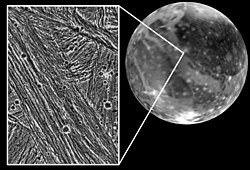 View of a portion of the Uruk Sulcus region on Ganymede showing how the fine details of the grooved terrain that are the principal features in the brighter regions of this satellite relate to the global view of the moon. | |
| Feature type | Sulcus |
|---|---|
| Coordinates | 0°48′N160°18′W / 0.8°N 160.3°W [1] |
| Diameter | 2,200 km (1,400 mi) |
| Eponym | Uruk |
Uruk Sulcus is a bright region of grooved terrain adjacent to Galileo Regio on Jupiter's moon Ganymede. It is thought to be younger than the darker material in Galileo Regio and similar regions elsewhere on the moon.
